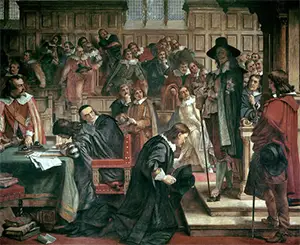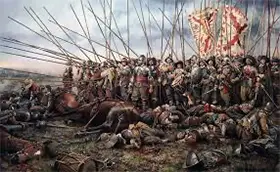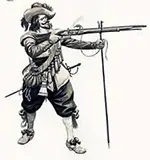The English Civil Wars
Charles found creative ways to raise money without the need for Parliament to provide it. And yet, by mid-1640, after 11 years of what Charles called "personal rule," the royal treasury was nearly exhausted. A desperate Charles turned to the City of London, which refused to grant the king a loan. Charles got the same response from foreign monarchs. In 1640, Scottish forces had taken up arms against England. Charles himself had gone north to take control of an army in 1639, in what was known as the First Bishops' War. The Scottish resistance, both figuratively and literally, was larger than Charles expected, and he ended up signing a treaty to avoid a military conflict. The king decided that he needed more money to fund more of a military expedition and called Parliament into session, for the first time since 1629. Before Parliament assembled, however, English voters cast their ballots in a parliamentary election. A strong majority of anti-Charles MPs were among those in session when Parliament opened. They made the most of their rejection of Charles's appeals for military funding and other measures and, instead, set about introducing measures of their own that strongly voiced their disapproval of Charles and his conduct. This resentment was primarily in the House of Commons, the lower house of Parliament. Charles still had support in the upper house, the House of Lords. All the same, Charles decided that he didn't need Parliament anymore and dissolved it. It was less than a month in session and came to be called the Short Parliament. Scotland chose this moment to invade, and Charles went back north to take charge of the army. Scotland defeated England at the Battle of Newburn and solidified their control of English territory in the north. Charles called a great council of peers, whose advice was to sue for peace. Charles reluctantly agreed and then summoned Parliament again. This latest Parliament, which came to be known as the Long Parliament, set about opposing the king in a very meaningful way by bringing about impeachment charges against Charles's lead advisors, including his principal advisor, the Earl of Strafford, and Archbishop William Laud. To cover its bases, Parliament passed the Triennial Act, requiring the king to summon Parliament at least once every three years and providing for a secondary issuance from a parliamentary council if the king refused. 
Parliament had, in November 1641 under the leadership of John Pym, issued the Grand Remonstrance, a long list of offenses by the king and his ministers against Parliament and the people that dated to the beginning of his reign. Charles responded in devastating fashion the following January by marching into Parliament with an armed guard and demanding the arrest of five members of the House of Commons and one member of the House of Lords. The intended prisoners had been tipped off, however, and were not in Parliament when Charles and his soldiers arrived. Charles left empty-handed, but his actions convinced even some of his strongest supporters that he had breached one too many conventions. Never before had an English monarch entered the House of Commons without an invitation, and the presence of armed soldiers was a compounding of the offense. Parliament responded with a precedent of its own, passing the Militia Ordinance, which gave the responsibility of appointing militia commanders to Parliament, not the king. Charles, naturally, refused to give his Royal Assent for the bill, but Parliament declared the ordinance in effect anyway, the first time ever that a law was declared valid without Royal Assent. Parliament took control of London, which had been against Charles for a time anyway, and the king went to Hampton Court Palace, then Windsor Castle, and then north, to try to find an army that would defend him. In broad terms, Charles enjoyed support in northern and western England and in most of Ireland and parliament had support in southeastern England and Scotland. The king got plenty of soldiers to fight for his cause. The same was true for the leaders of Parliament, with Robert Devereux, the Earl of Essex leading the way. Both sides took up arms in earnest, and the English Civil War began. 
The main mechanism of fighting for both sides was infantry, which consisted of musketeers (wielding guns up to five feet long and having a range of 300 yards) and pikemen (wielding metal-tipped 12-foot-long wooden weapons). The soldiers firing muskets would stand in three rows–one kneeling, one The heavy artillery consisted of mortars and cannons. It took more than a dozen horses to move the heavy cannons from place to place. The soldiers who fired the cannons used stones when they ran out of iron cannon balls. A mortar was smaller and, therefore, easier to move around. As long as enough shells were available, mortars proved very effective during battles. The soldiers themselves wore armor if they could afford it and a leather tunic if they had much less money or much less access to a kindly disposed noble. Those not armed with guns or pikes wielded swords. The first major cavalry battle was at Powick Bridge. The king's nephew, Prince Rupert of the Rhine, led the Royalist forces to victory. The first sustained battle took place at Edgehill on Oct. 23, 1642. Charles put his trust again in his nephew, rather than his military commander, Lord Lindsey, who promptly resigned his post. Lindsey still fought in the battle and died from wounds he sustained. Neither side gained the upper hand on the battlefield, and darkness ended the fighting. The next month, the two sides fought three minor battles: The Royalists won at Aylesbury, the Parliamentarians won at Brentford, and Turnham Green was a standoff. Not for the last time, the king and his forces regrouped at Oxford. Two weeks later, a Royalist force marched on London but, met with superior numbers, broke off its march. Charles and his forces returned to Oxford and spent the winter there. 
The following year, the two sides talked peace but could come to no mutually beneficial arrangement. Unlike modern wars, the pace of battle and troop movements was quite slow during this war. Weather often hindered the movement of troops and equipment–especially with the heavy artillery such as cannons and mortars, which would get bogged down in the mud–and weapons for many were hard to come by; as well, the soldiers who fought in this war were, early on, volunteers who may or may not have been paid for their service. When not marching with or fighting for the king or the parliamentary side, the soldiers were living out their lives much as they had been–farming, conducting business, and looking after their families. Small skirmish followed small skirmish, and some of these can quite rightly be called battles, but the number of major battles was quite small. Next page > The End of the Line > Page 1, 2, 3 |
|
Social Studies for Kids
copyright 2002–2024
David White



 crouching, and one standing; in this way, they could all fire at once without getting in one another's way. The pikemen would stand guard around the musketeers, to protect against charges by cavalry and to give the gunners time to reload (a lengthy process). Both sides used cavalry charges to disrupt and disperse the enemy infantry. The men aboard the horses would carry a small gun, routinely charge to just outside pike range, and fire their handheld weapon.
crouching, and one standing; in this way, they could all fire at once without getting in one another's way. The pikemen would stand guard around the musketeers, to protect against charges by cavalry and to give the gunners time to reload (a lengthy process). Both sides used cavalry charges to disrupt and disperse the enemy infantry. The men aboard the horses would carry a small gun, routinely charge to just outside pike range, and fire their handheld weapon.

